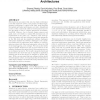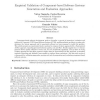SIGOPS
2011
13 years 7 months ago
2011
Heterogeneous processors that mix big high performance cores with small low power cores promise excellent single– threaded performance coupled with high multi–threaded through...
AOSD
2011
ACM
13 years 7 months ago
2011
ACM
Software systems are increasingly being built as compositions of reusable artifacts (components, frameworks, toolkits, plug-ins, APIs, etc) that have non-trivial usage constraints...
INTERACTIONS
2010
13 years 9 months ago
2010
s from a concrete to a new abstract level of description [1]. Rises in abstraction level happen regularly in all fields, but the key difference in Alexander's work was that ra...
INFSOF
2010
13 years 9 months ago
2010
Successful software development and management depends not only on the technologies, methods and processes employed but also on the judgments and decisions of the humans involved....
ICSE
2010
IEEE-ACM
13 years 9 months ago
2010
IEEE-ACM
Developers change source code to add new functionality, fix bugs, or refactor their code. Many of these changes have immediate impact on quality or stability. However, some impact...
EMSOFT
2010
Springer
13 years 9 months ago
2010
Springer
Model-driven architecture (MDA) is a model-based approach for engineering complex software systems. MDA is particularly attractive for designing embedded systems because models ca...
CLEIEJ
2010
13 years 9 months ago
2010
Component-based software development needs to formalize a process of generation, evaluation and selection of Composite COTS-based Software Systems (CCSS), enabling software archit...
CLEIEJ
2010
13 years 9 months ago
2010
Formalizing and institutionalizing software processes has become a necessity in recent years requiring the management and enhancement of software production and, at the same time,...
CACM
2010
13 years 10 months ago
2010
Certified software consists of a machine-executable program plus a formal machine-checkable proof that the software is free of bugs with respect to a claim of dependability. The c...
IFIP12
2009
13 years 10 months ago
2009
: Component-based software development has matured into standard practice in software engineering. Among the advantages of reusing software modules are lower costs, faster developm...




